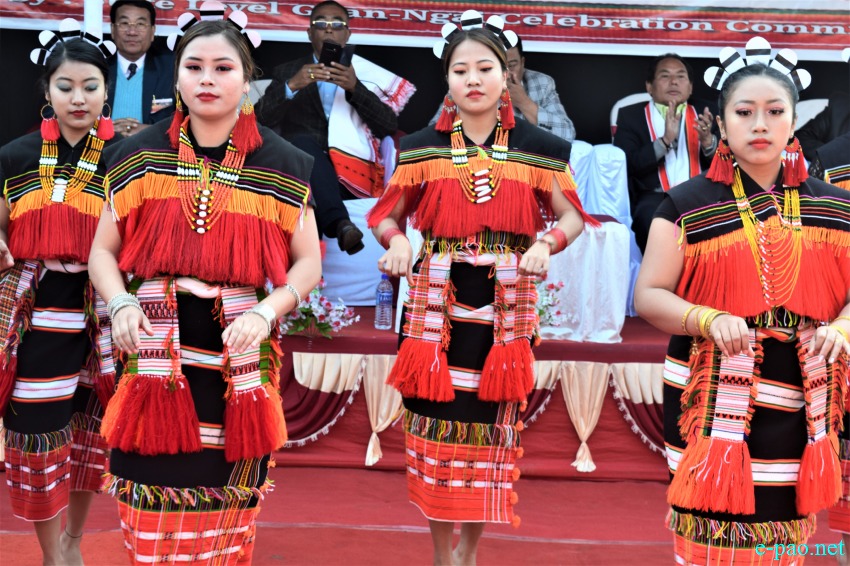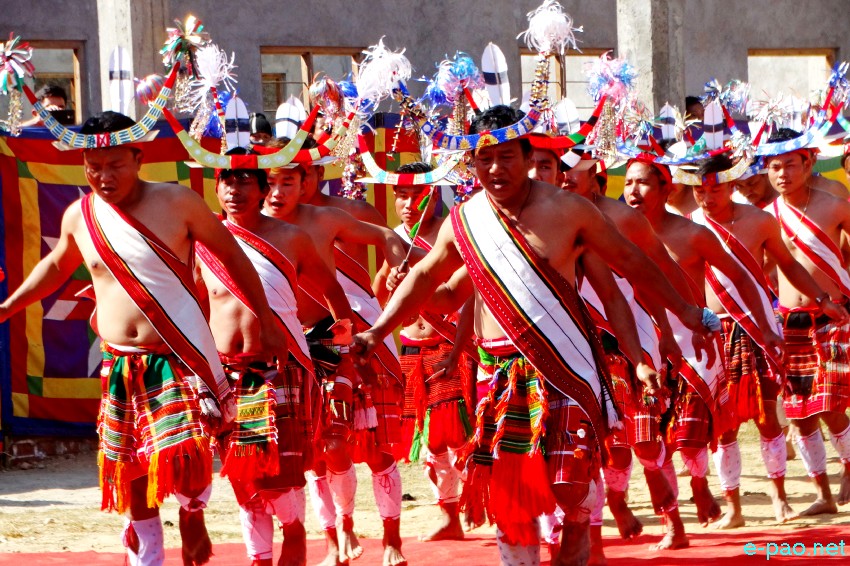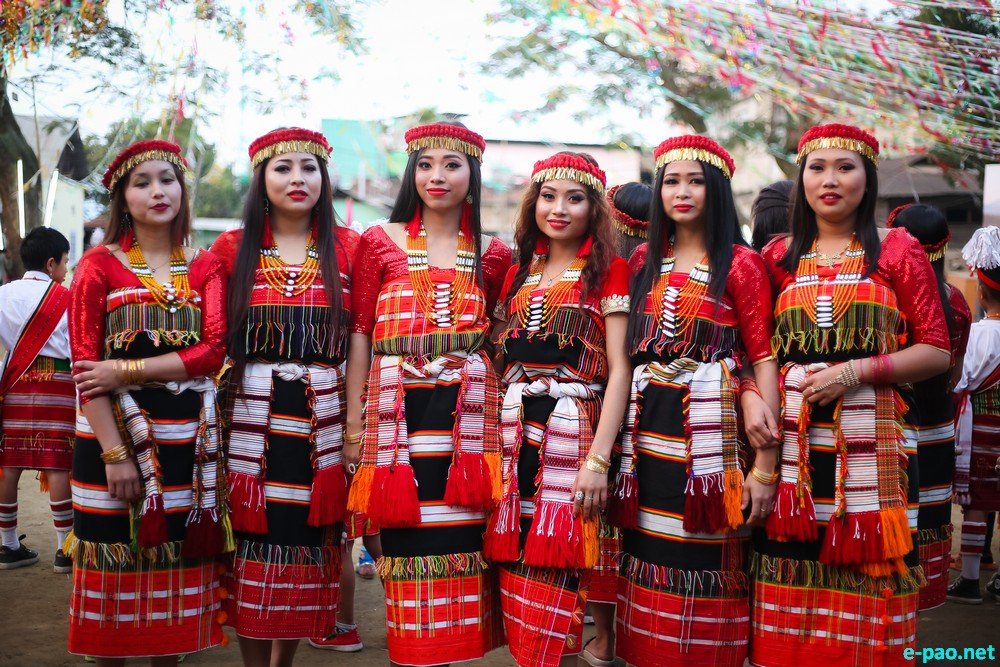Costume and textiles of Kabui Naga tribe of Manipur
- Crafting traditions -
Joymati Thoudam / Dr Ritu Mathur *

Gaan-Ngai at Ramji Kabui Khul, Imphal on 9th January 2020 :: Pix - Oken Luwang
Tradition is a form of artistic heritage of particular culture, beliefs and custom of a community. Handicraft is one of the major sectors of which provided useful and decorative objects made completely by hand or by using simple tools. The Kabui tribe of Manipur has been crafting their traditions through their enchanting traditional textiles by unique creativity and skill of the weavers.
The Kabui tribe is one of the indigenous communities of Manipur belonging to the Tibeto-Burman family. They are also known by the name Rongmei. Rongmei means people of the south or southerners. The original home of the Kabui lies in Tamenglong district, the western borders of Manipur. Kabuis are also scattered in Imphal district of Manipur.
Traditions say, the Kabui ancestors originated from a cave locally known as Mahou Taobei, which is believed to be located somewhere near Makhel, Senapati district of Manipur. It was also believed that China was the ancestral homeland of Kabui tribe and they migrated in different directions and settled in North Eastern part of India through Myanmar.
The Kabui tribe possesses cultural and religious denominations of their traditional textiles and have specific significance, symbolism, colours and design. Every house of Kabui has one or two loin looms. Traditionally, mother taught the weaving process to her daughter from a tender age. It was imperative for women to be skilled in weaving. It is believed that in earlier times, the tribe people buried their dead woman along with her weaving implements for use in the next world.
Most of the design or motifs were represented their mythological beliefs. They also copied design or motifs from the crafted/painted designs on traditional house and objects in their surroundings. Most of the cloths were woven in plain weave and extra weft technique was used for designing motifs. Most of their garments were made by joining two or more woven cloths by hand stitching.
Cotton was mainly used to weave traditional textiles. They harvested cotton themselves and spin it into yarn for weaving. Traditionally, colours such as red, white/off white, yellow, green, black and light brown were used for their cloths. The tribe people also practiced the art of dyeing by using naturally sustainable raw materials such as bark of tree, leaves, stem, roots, flowers and fruits. They used to dye yarns for weaving as well as cane, bamboo stalk or animal hair for their accessories.
In earlier days, the traditional textiles and costume of Kabui were regulated on the basis of age and sex of the wearer rather than social status. The tribe people buried the dead with cloths or when a child is sick, the old loin cloth of mother used to cover the body so that evil forces could not harm her or him. The traditional textiles of Kabui tribe can be broadly grouped into (i) home textile (ii) unisex textile (iii) male garment (upper and lower) and (iv) female garment (upper and lower).

Gaan-Ngai at Chingmeirong, Kabui Khul, Imphal on January 19 2019 :: Pix - Shankar Khangembam
Langbun Phei is an off-white plain cloth woven from coarse cotton yarn used as a blanket (home textile) during winter for the family. Unisex garments consist of Pheirak and Mareipan. Pheirak is a long scarf worn by males and females as waist binder while they perform dance. It is known as Bungkam when worn by women folk.
Mareipan is a shawl and can be worn by unmarried males and females who were eligible to enter Khangchu and Luchu (Khangchiu and Luchiu are boys and girls dormitory respectively). However, with passage of time Mareipan shawl has become popular amongst the men folk.
According to the elder respondents of the community, upper garments for males were designated according to their age. A plain white cloth with red colour border called Sinei Phei was worn by male children in order to protect them from evils and black art. Then, when male children turned into adolescents and entered boy's dormitory called Khangchiu they could wear Themphei shawl. It is woven in black base with small white stripes.
One of the famous shawls used by the middle aged males is Pheingao which is woven in off white base with broad red border. The shawl is designed with Pheingao hu at two ends of the cloth and Pheibei design on red broad border of the shawl.
According to information received from the tribe people, Pheingao hu design was inspired from the art painted on the wall of the Tarangkai, the traditional ceremonial house of Kabui. It signified the mark of God. Pheibei is a long-dotted line usually woven in two colours i.e. yellow and black alternately, which was used on their cloths in order to protect them from downfall or anything unpleasant.
One of the most reserved cloths for the elder men folk is Chingkhuong Phei. It is a black colour base and broad red border shawl. The term "Chingkhuong" was derived from the word "Chingkho" meaning rich family/rich people or honoured people in Kabui dialect. Therefore, the shawl was permitted to be worn only by these people. The other inseparable cloth for men is Masim Pheipong. It is plain white and can could be worn only by aged persons. It is also used in funerals to cover the dead body.
The commonly used lower garment of men folk includes Songnai, Inthiknai and Lenglan. Songnai is a red colour based cloth without motifs or design but with small white stripes at panels of the garment. The lower garment is worn during festivals and dances by young boys.
Another rectangular loin cloth woven in plain black is Inthiknai. The cloth is ornamented with three or four rows of cowries shell. This loin cloth was worn by men while they work in fields, hunting, war as well as festivals. The special loin cloth woven for men to be worn during dances and festivals is Lenglan. It is woven in white stripes on red colour base with decorated fringes at the border of the cloth. Earlier, Lenglan was also used as a marriage costume by the grooms. Senlam is a green colour long scarf used as a waist binder by male folk while performing dances.
In earlier days, the tribal women wore mostly sarong called as Pheisoi in Kabui dialect to cover their chest. However, women used Phangphei as bustier on special occasion and dances. It is plain black long scarf ornamented with decorative tassels. The tassels are made up of red dyed goat hair as fringes and coiled spirally by dried stem of an orchid called Kung.
For women folk, lower garments were a medium to signify their age and social status. Some of the important lower garments of women are Langjin Pheisoi, Langmiu Pheisoi, Lengli Pheisoi, Khim Pheisoi and Nai. The most popular Pheisoi amongst women folk is Langjn Pheisoi. It is woven in light brown colour cotton with black and white stripes.
The lower garment is designed with Pakban motif in red and black colours at joints of the panels of cloth by hand embroidery. According to information received Pakban motif was inspired from butterfly. For special occasions and dances, women wore Langmiu Pheisoi. It is woven in black colour base with red colour border patterned with broad white stripes. In earlier days, it was also worn by brides as a part of bridal costume.
Lengli Pheisoi is a lower garment especially woven for girl child. Khim Pheisoi is woven in black colour with small white stripes. It is worn by women during funerals. Also, it is worn by aged women. Nai is an inner wear for ladies. It is usually worn above knee length. Nai is especially used for funerals. When a woman died, she was dressed with Nai as inner garment and a Pheisoi was draped over it.

Gaan-Ngai at Ragailong on January 2018 :: Pix - Somorendro Sorokhaibam
Jewellery and ornaments are an integral part of Kabui traditional costumes. They adorn themselves with specific ornaments during occasions and dances. The traditional ornament of Kabui tribe can also be categorised as unisex, male and female ornaments.
Unisex ornaments is Ta-dan-tu (cornelian beads necklace). Male ornaments are Tu (conch shell and bone neckwear for warrior and hunter), Guak nai Ta (boar tusk neck wear for warrior), Guangkuam (conch shell neck wear), Jeipu (ear wear made of feather from a bird called Jeipu), Chei (head wear made from cane, bamboo stalk and cotton ball), Chirong (head wear made of bamboo splints), Langbun (cotton balls usually worn with bird feather on top of head), Banpomta (circular arm wear made from ivory or sometimes wood).
Leg wear such as Phaisang (cane leg wear), Phaikam (leg wear made from cotton cloth and dried orchid stem tassels), Pheidom (Plain white cotton cloth leg wear). Apart from this, Kabui males used to paint on their legs below the knee by using rice paste and it is called as Dah Inpanmei.
Female ornaments consists of Beithingnem (ear wear made from beads and cotton thread), Ta-du and Nathang (brass arm wear), brass bangles, Langdai ma (head wear made from bird feathers), Pikhim (head wear made from bamboo stalk, flowers and bird feathers), Sanadong/Kachakdong (ritual head wear made from bamboo, wood and buffalo horn).
It was noted that in earlier days, the traditional textiles and costumes of Kabui tribe had functional value and helping in strengthening its moral, aesthetic and ideological foundations. The traditional textiles have crafted rich tradition by playing a significant role.
Today, there is no specific restriction to wear clothes as in the past. In addition to this, traditional dyeing and spinning practices are not popular amongst the community. However, loin loom weaving is still practiced by women folk.
Due to change in life style, the tribe people have added more to their textiles in terms of raw material, colours and uses. Some of the traditional textiles are not commonly used except for the few which are worn on ritual functions, dances and occasions.
* Joymati Thoudam / Dr Ritu Mathur wrote this article for The Sangai Express
Joymati Thoudam, Research Scholar and Dr. Ritu Mathur, Associate Professor Dept. of Fabric & Apparel Science (Home Science) Lady Irwin College, University of Delhi
They can be reached at joymati(DOT)thoudam(AT)gmail(DOT)com, ritumathur16(AT)gmail(DOT)com
This article was posted on June 17, 2021.
* Comments posted by users in this discussion thread and other parts of this site are opinions of the individuals posting them (whose user ID is displayed alongside) and not the views of e-pao.net. We strongly recommend that users exercise responsibility, sensitivity and caution over language while writing your opinions which will be seen and read by other users. Please read a complete Guideline on using comments on this website.







